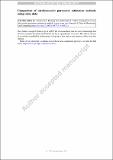| dc.contributor.author | Arai, Tatsuya | |
| dc.contributor.author | Lee, Kichang | |
| dc.contributor.author | Cohen, Richard J. | |
| dc.date.accessioned | 2021-01-09T02:09:52Z | |
| dc.date.available | 2021-01-09T02:09:52Z | |
| dc.date.issued | 2019-05 | |
| dc.date.submitted | 2018-11 | |
| dc.identifier.issn | 1573-2614 | |
| dc.identifier.uri | https://hdl.handle.net/1721.1/129354 | |
| dc.description.abstract | Abstract: In this study, new and existing methods of estimating stroke volume, cardiac output and total peripheral resistance from analysis of the arterial blood pressure waveform were tested over a wide range of conditions. These pulse contour analysis methods (PCMs) were applied to data obtained in six swine during infusion of volume, phenylephrine, dobutamine, isoproterenol, esmolol and nitroglycerine as well as during progressive hemorrhage. Performance of PCMs was compared using true end-ejection pressures as well as estimated end-ejection pressures. There was considerable overlap in the accuracies of the PCMs when using true end-ejection measures. However, for perhaps the most clinically relevant condition, where radial artery pressure is the input, only Wesseling’s Corrected Impedance method and the Kouchoukos Correction method achieved statistically superior results. We introduced a method of estimating end-ejection by determining when the systolic pressure dropped to a value equal to the sum of the end-diastolic pressure plus a fraction of the pulse pressure. The most accurate estimation of end-ejection was obtained when that fraction was set to 60% for the central arterial pressure and to 50% for the femoral and radial arterial pressures. When the estimated end-ejection measures were used for the PCMs that depend on end-ejection measures and when radial artery pressure was used as the input, only Wesseling’s Corrected Impedance method and the modified Herd’s method achieved statistically superior results. This study provides a systematic comparison of multiple PCMs’ ability to estimate stroke volume, cardiac output, and total peripheral resistance and introduces a new method of estimating end-systole. | en_US |
| dc.publisher | Springer Netherlands | en_US |
| dc.relation.isversionof | https://dx.doi.org/10.1007/s10877-019-00322-y | en_US |
| dc.rights | Creative Commons Attribution-Noncommercial-Share Alike | en_US |
| dc.rights.uri | http://creativecommons.org/licenses/by-nc-sa/4.0/ | en_US |
| dc.source | Springer Netherlands | en_US |
| dc.title | Comparison of cardiovascular parameter estimation methods using swine data | en_US |
| dc.type | Article | en_US |
| dc.identifier.citation | Arai, Tatsuya et al., "Comparison of cardiovascular parameter estimation methods using swine data." Journal of Clinical Monitoring and Computing 34, 2 (April 2020): 261–70 ©2019 Authors | en_US |
| dc.contributor.department | Massachusetts Institute of Technology. Department of Aeronautics and Astronautics | en_US |
| dc.contributor.department | Massachusetts Institute of Technology. Institute for Medical Engineering & Science | en_US |
| dc.relation.journal | Journal of Clinical Monitoring and Computing | en_US |
| dc.eprint.version | Author's final manuscript | en_US |
| dc.type.uri | http://purl.org/eprint/type/JournalArticle | en_US |
| eprint.status | http://purl.org/eprint/status/PeerReviewed | en_US |
| dc.date.updated | 2020-09-24T20:36:50Z | |
| dc.language.rfc3066 | en | |
| dc.rights.holder | Springer Nature B.V. | |
| dspace.embargo.terms | Y | |
| dspace.date.submission | 2020-09-24T20:36:50Z | |
| mit.journal.volume | 34 | en_US |
| mit.journal.issue | 2 | en_US |
| mit.license | OPEN_ACCESS_POLICY | |
| mit.metadata.status | Complete | |
